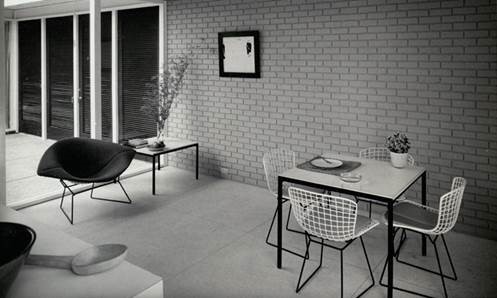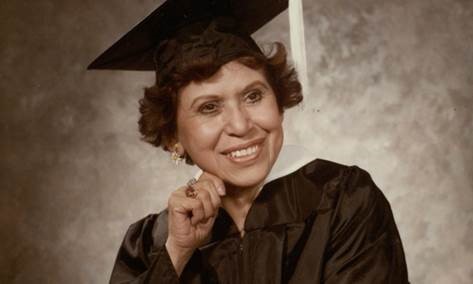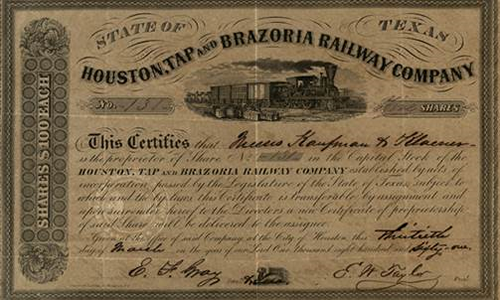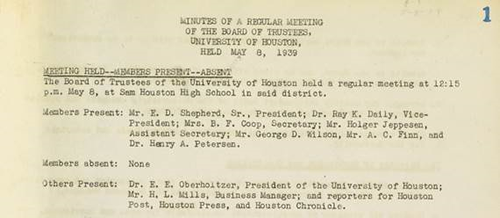New Digital Collection: Burdette Keeland Architectural Drawings and Photographs
Burdette Keeland, Jr. was an influential Houston architect who left a legacy as a designer, an educator, and a member of the Houston Planning Commission. At the peak of his practice, from 1950 to 1980, Keeland produced some of the city’s best modernist architectural design. Yet he will also be remembered for his four decades on the faculty of the University of Houston, where he dedicated himself to mentoring the next generation of architects. This digital collection provides a sample of five of his imaginative works, including architectural drawings and renderings, photographs, clippings, and audio interviews.

The Burdette Keeland Architectural Drawings and Photographs collection is now available in the University of Houston Digital Library.
A 1950 graduate of the University of Houston, Keeland quickly developed a successful architectural practice. As with many architects of the period, his work of the 1950s reflected the influence of Ludwig Mies van der Rohe and Philip Johnson. Keeland’s innovative design for the Fred Winchell Studio and Apartments (with Harwood Taylor, 1953) combined a professional office with rental apartments on a small city lot. Two years later he produced his best-known work, a steel-frame residence for homebuilder W. K. King, featured in the 1955 Meyerland Parade of Homes.
In the 1960s Keeland’s work expressed other trends in architectural design. He interpreted the Brutalist aesthetic in the Essex-Houck Office Building (with Herman F. Goeters, 1962), where his tight grouping of masonry towers gave this small office building a sense of the monumental. In the Williams Beach House of 1967 (with Alan Rice), his crisp, shed-roofed volumes evoked the barnlike structures of California’s iconic Sea Ranch development.
Keeland experimented with new ideas in his own house on Ferndale Street. In 1976 he transformed a modest 1930s house into an urban retreat for his family. He made further changes in the 1980s and 1990s, but the rear courtyard received the most attention. He showed his flair for artistic and whimsical details in the over-scaled metal column that supports a second floor overhang; a few feet away a vine-covered spiral staircase offered access to a roof-top office and observation deck.
The original materials are available in UH Libraries Special Collections in the Burdette Keeland Architectural Papers.
New Digital Collection: Mary F. Lopez Papers
The Mary F. Lopez Papers document the life and times of Mexican-American activist Mary F. Lopez (1921-2015), and to a lesser extent the war-time experience of her husband, Jose R. Lopez. Originally born in Brownsville, Texas, Mary Fernandez Lopez later moved to Houston in 1943, where she started a family and began her involvement in efforts to improve living conditions and rights of Latinos in the Houston area, specifically her neighborhood of Magnolia Park.

The Mary F. Lopez Papers collection is now available in the University of Houston Digital Library.
Of the 80 items in the collection, photographs, correspondence, publications, and clippings make up the bulk of the collection. Materials related to Mr. Lopez’s service in World War II and Mary’s work with Houston civic organizations are of particular interest.
The original materials are available in UH Libraries Special Collections in the Mary F. Lopez Papers.
New Digital Collection: City of Houston, Its Development and Evolution
Long before Houston was the fourth largest city in the United States and referred to as the Energy Capital of the World, up until the twentieth century, it was simply called the Magnolia City for its natural magnolia groves found flourishing in east Houston. Although it was a simpler time, Houston was still a city on the move beginning to transform itself into the metropolis we know today, and many historical documents illustrate this shift as the City of Houston began to initiate efforts to expand commerce and transportation networks.

The City of Houston, Its Development and Evolution collection is now available in the University of Houston Digital Library.
A selection of 247 items, including drafts and published versions of Houston’s charters and codes of ordinance are included. These documents from 1847 to 1897 were the founding documents establishing Houston as a municipality along with enacted laws that would govern the city at this time. Many of the documents are from the Reconstruction period in Houston after the Civil War between 1865 and 1877. During this period, Houston became a global hub of commerce through its shipping port, initially transporting cotton and lumber, and later oil. Railroads were also built to connect the Port of Houston with rail lines to transport goods and resources to and from the Port of Houston to all parts of the country.
Also included are documents from the Engineer’s Office and Streets and Bridges department concerning the city’s infrastructure, and letters and memos from city council members, mayors, and aldermen discussing policy and legislation. Other noteworthy items include payrolls and other documents relating to the activities of the Houston Police, Fire Department, and Public Schools that provide emergency and educational services to the citizens of the community.
The original materials are available in UH Libraries Special Collections in the George Fuermann “Texas and Houston” Collection.
New Digital Collection: Board of Regents Records
The University of Houston was established in 1927 as the Houston Junior College. It grew and prospered to become the University of Houston in 1934. In 1939, the institution acquired land for a permanent campus and opened its first building. The university became a state institution in 1963 and joined the newly created University of Houston System in 1977.

The Board of Regents Records collection is now available in the University of Houston Digital Library.
The Board of Regents Records include the minutes from the meetings of the Board of Trustees between 1939 and 1944, and later, the Board of Regents, the governing body of the University of Houston system. The meeting minutes provide insights into the evolution and governance of the University. Digitization of these records is ongoing, and subsequent volumes will be added to the UH Digital Library as they become available.
The original materials are available in UH Libraries Special Collections.